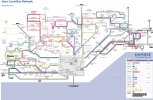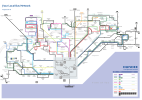tbtc
Veteran Member
Many places have seen their "outer circles" trimmed back/ cut into multiple services, so that more and more journeys would mean having to go into the city centre and back out again
The "Strathclyde" thread started a discussion about the (apparent) need for orbital links, providing a grid-like combination of services rather than only having radial routes
I can see why it's an attractive argument - especially if you enjoy abstract concepts - who wouldn't want a wholesome network providing huge numbers of journey opportunities rather than just routes down the main road into the town/city centre, and everyone having to change there
But, rather than abstract discussions about how things work in theory, what "orbital" routes are lacking from UK cities (or large towns)? Or, examples of links that may have an hourly tendered service but not the kind of high frequency link that you might need to encourage people to change twice in the suburbs rather than making one change between frequent services in the city centre?
"orbital" can be subjective, e.g. you could argue that Bolton/ Bury/ Rochdale/ Oldham are all reasonably large towns and that any service between two or more of them is simply linking these towns rather than a "Manchester orbital" service - the same could be said of First's 201 from East Kilbride - Hamilton - Motherwell - Coatbridge - Airdrie being a link between towns of Lanarkshire rather than a "Glasgow orbital" service - I'm certainly not talking about circular routes - only about services that link different parts of a town/city without going into the centre
Here in Sheffield we've lost a lot of orbital services, or seen them significantly reduced. For example, Manor Top was a busy interchange (a major junction in the south east of the city, on the tram network) with up to twenty buses per hour round the ring road to Darnall (2/10/11/20/59/70/71/711), of which up to six continued to Meadowhall. Now, there's only one bus per hour (18). I could see the argument that a better frequency from Manor Top to Meadowhall would make a number of journeys more attractive by public transport. However, we are in a period of retrenchment where most busy radial routes have been reduced in frequency with no scope to introduce non-core services as things stand
Where else though? What about your city (or large town)? What are the biggest links that we'd need to turn a simple route map into a proper network that allows several options to get around without having to go into/through the centre?
The "Strathclyde" thread started a discussion about the (apparent) need for orbital links, providing a grid-like combination of services rather than only having radial routes
I can see why it's an attractive argument - especially if you enjoy abstract concepts - who wouldn't want a wholesome network providing huge numbers of journey opportunities rather than just routes down the main road into the town/city centre, and everyone having to change there
But, rather than abstract discussions about how things work in theory, what "orbital" routes are lacking from UK cities (or large towns)? Or, examples of links that may have an hourly tendered service but not the kind of high frequency link that you might need to encourage people to change twice in the suburbs rather than making one change between frequent services in the city centre?
"orbital" can be subjective, e.g. you could argue that Bolton/ Bury/ Rochdale/ Oldham are all reasonably large towns and that any service between two or more of them is simply linking these towns rather than a "Manchester orbital" service - the same could be said of First's 201 from East Kilbride - Hamilton - Motherwell - Coatbridge - Airdrie being a link between towns of Lanarkshire rather than a "Glasgow orbital" service - I'm certainly not talking about circular routes - only about services that link different parts of a town/city without going into the centre
Here in Sheffield we've lost a lot of orbital services, or seen them significantly reduced. For example, Manor Top was a busy interchange (a major junction in the south east of the city, on the tram network) with up to twenty buses per hour round the ring road to Darnall (2/10/11/20/59/70/71/711), of which up to six continued to Meadowhall. Now, there's only one bus per hour (18). I could see the argument that a better frequency from Manor Top to Meadowhall would make a number of journeys more attractive by public transport. However, we are in a period of retrenchment where most busy radial routes have been reduced in frequency with no scope to introduce non-core services as things stand
Where else though? What about your city (or large town)? What are the biggest links that we'd need to turn a simple route map into a proper network that allows several options to get around without having to go into/through the centre?


